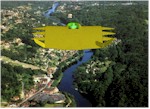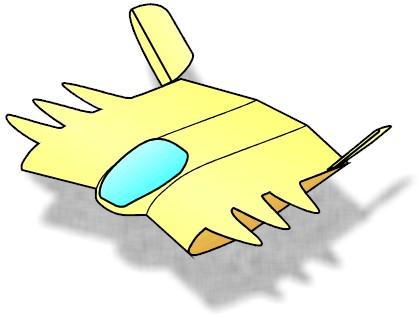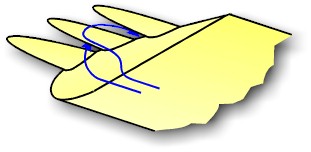 |
||||||
The created vortexes of low aspect ratios are huge at low speed. These
huge vortexes influence a certain area of the very short span. This leads
to bad span efficiency. I hope to show a way to resolve this problem.
|
||||||
|
Many of you have already seen winglets. Some of you
have seen experiments using "feathers" (I haven't found any
official name, so I call them feathers and will do so for the rest of the
text). How do I hope they work? So, under the wing there is a positive pressure
and above the wing there is a negative pressure. The positive pressure
will of course leak towards the negative pressure. This happens along the
tip of the wing. Wingtips have a certain form and according to that form a
certain length of space where the air can leak to the other side of the
wing. The shorter this space the more force the leaking air will have (I
don't mean that high aspect ratios (= long wings with short airfoils) have
larger vortexes then low aspect ratios) . Imagine you push a bucket of
water over that was standing on a table. At the table edge each centimeter
or inch will get a certain amount of water over it. If you pushed the
bucket towards the short side of the table each centimeter or inch will
have to swallow more water than if you pushed it to the long end of the
table. Now, how do you increase the wingtip edge length? You could do that in
two ways. The first way is to increase length of the tip chord. But that
would be difficult in construction. The wingtip would get more lift than
the root chord. This could leads to extra forces on the spar at the root.
The second way to increase the length of the wingtip edge is to deform the
wingtip. By making featherlike extensions on the tip you made that edge
longer. There are more centimeters or inches along the wingtip.
A
view on the underside of the wingtip. The air leaks between the feathers,
but not all the air can pass. So some of the air will take the way along
the feathers. I hope that this will reduce the force of the leaking air. If it does it
will also reduce the force of the vortexes. And that would make that the
airplane has a better span efficiency. A second thing about the feathers that could help reduce the vortexes is
the use of several leaks instead of one leak. Let me explain. An
unfeathered wingtip has one major leak, the entire wingtip. A feathered
wingtip can have more leaks. I don't mean that the leak power is greater,
but that between each feather you will have a leak. If you only have one
leak, this certainly will lead to a vortex. But two leaks next to each
other disturb each other in creating a vortex. Just try it out in water.
Making quick circles with one finger in the water leads to a vortex. Now
try doing this with two fingers. Just try to create two vortexes next to
each other. It will be more difficult. So when you make experiment, make
sure to use several feathers (definitely more than 2). There is one thing that also needs to be tested by models. Do the
feathers need to be installed on the top of the wingtip (as seen in the
drawings) or must they be placed on the bottom? I cannot imagine what the
difference will be, but I am sure there will be a difference. One mistake you may not make is the next. Do not turn one of these
feathers into an aileron (= control area which creates a roll maneuver).
The spaces between the ailerons will lead to leaks at unwanted places.
That is why I drew a kind of V-tail. I wanted to cooperate all control
areas into this tail. Kind of a combination off elevons (= combination of
elevators and ailerons) and a vertical tail. I didn't have an opportunity
to test it. But I leave that fun to those who want to try out this idea
into some models. Feel free to use this idea in your models. Please report me any good or
bad flight results. I was glad to see that my thought about these
vortex-reducing feathers actually works (imagine a man dancing while
singing "it works, it works, it woooorks"). |
||||||
 |
 |
 |
 |
|||
I got these 3D-pictures from Romain
Schoenenberger. He called them "quickies". I call them beauties. |
||||||
|
I replied: “I like to react on your comment on the Birdwing-idea.
OK, I see now that the stall speed will increase due to a lower CL max. I
even did find on the new site of Winggrid that the test plane had a higher
stall speed. So, it proofs that you are right. Anyway... I did not doubt
your remark. You know your stuff.
His reaction was: "Sounds like a good plan to
me! I hope to learn the outcome of the experiments. That the Horton
"wingless" seemed to work well with its "tip"
plates indicates that you may be on a good path." This shows again that maybe my Birdwing-idea can be used in planes with more normal aspect ratio. If somebody can get me into contact with David Marsden I can learn more about his winglets and ask his opinion about my Birdwing. All extra info will be placed in the site.
A tip to all: those that did visit the site of Winggrid, should visit it
again. They now have a small, motorized glider built to test the winggrid.
This time the winggrids have a fixed position and the winggrids end in a
vertical connection. |
||||||

